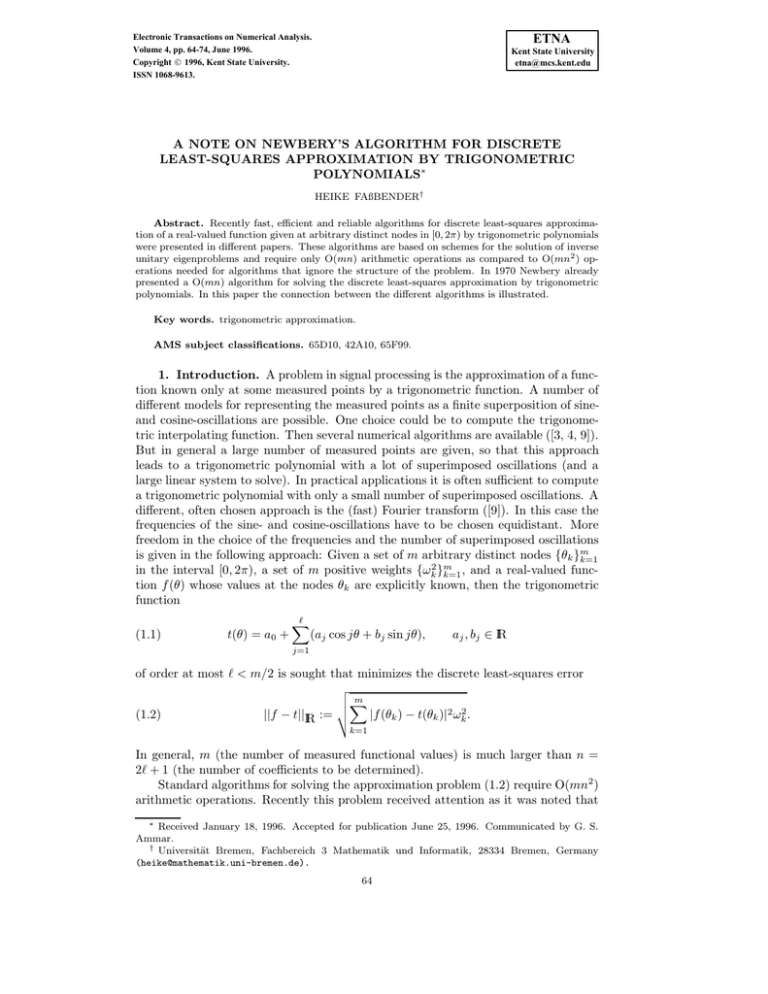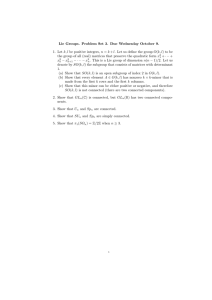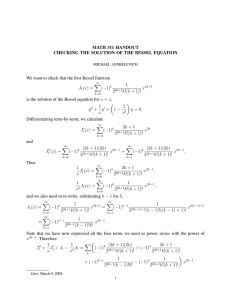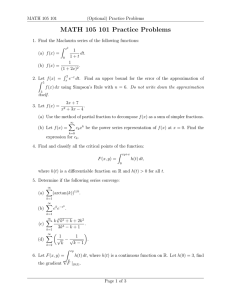ETNA
advertisement

ETNA
Electronic Transactions on Numerical Analysis.
Volume 4, pp. 64-74, June 1996.
Copyright 1996, Kent State University.
ISSN 1068-9613.
Kent State University
etna@mcs.kent.edu
A NOTE ON NEWBERY’S ALGORITHM FOR DISCRETE
LEAST-SQUARES APPROXIMATION BY TRIGONOMETRIC
POLYNOMIALS∗
HEIKE FAßBENDER†
Abstract. Recently fast, efficient and reliable algorithms for discrete least-squares approximation of a real-valued function given at arbitrary distinct nodes in [0, 2π) by trigonometric polynomials
were presented in different papers. These algorithms are based on schemes for the solution of inverse
unitary eigenproblems and require only O(mn) arithmetic operations as compared to O(mn2 ) operations needed for algorithms that ignore the structure of the problem. In 1970 Newbery already
presented a O(mn) algorithm for solving the discrete least-squares approximation by trigonometric
polynomials. In this paper the connection between the different algorithms is illustrated.
Key words. trigonometric approximation.
AMS subject classifications. 65D10, 42A10, 65F99.
1. Introduction. A problem in signal processing is the approximation of a function known only at some measured points by a trigonometric function. A number of
different models for representing the measured points as a finite superposition of sineand cosine-oscillations are possible. One choice could be to compute the trigonometric interpolating function. Then several numerical algorithms are available ([3, 4, 9]).
But in general a large number of measured points are given, so that this approach
leads to a trigonometric polynomial with a lot of superimposed oscillations (and a
large linear system to solve). In practical applications it is often sufficient to compute
a trigonometric polynomial with only a small number of superimposed oscillations. A
different, often chosen approach is the (fast) Fourier transform ([9]). In this case the
frequencies of the sine- and cosine-oscillations have to be chosen equidistant. More
freedom in the choice of the frequencies and the number of superimposed oscillations
is given in the following approach: Given a set of m arbitrary distinct nodes {θk }m
k=1
in the interval [0, 2π), a set of m positive weights {ωk2 }m
k=1 , and a real-valued function f (θ) whose values at the nodes θk are explicitly known, then the trigonometric
function
(1.1)
t(θ) = a0 +
X̀
(aj cos jθ + bj sin jθ),
aj , bj ∈ IR
j=1
of order at most ` < m/2 is sought that minimizes the discrete least-squares error
v
um
uX
(1.2)
||f − t||IR := t
|f (θk ) − t(θk )|2 ωk2 .
k=1
In general, m (the number of measured functional values) is much larger than n =
2` + 1 (the number of coefficients to be determined).
Standard algorithms for solving the approximation problem (1.2) require O(mn2 )
arithmetic operations. Recently this problem received attention as it was noted that
∗ Received January 18, 1996. Accepted for publication June 25, 1996. Communicated by G. S.
Ammar.
† Universität Bremen, Fachbereich 3 Mathematik und Informatik, 28334 Bremen, Germany
(heike@mathematik.uni-bremen.de).
64
ETNA
Kent State University
etna@mcs.kent.edu
Heike Faßbender
65
fast algorithms can be developed [11, 5, 7]. These algorithms are based on schemes
for the solution of inverse unitary eigenvalue problems and require merely O(mn)
arithmetic operations. Section 2 gives a short description of these algorithms. Already in 1970, Newbery [10] presented a O(mn) algorithm to solve the least-squares
approximation by trigonometric polynomials. This algorithm is closely related to the
algorithms described in Section 2. In Section 3 Newbery’s algorithm is given. Its
connection to the algorithms given in Section 2 is described in Section 4.
2. Algorithms based on the inverse unitary eigenproblem. In [11] Reichel, Ammar, and Gragg reformulate the problem (1.2) as the following standard
least-squares problem: Minimize
(2.1)
||DAc − Dg||2 = min,
where D = diag(ω1 , ..., ωm ) ∈ Cm×m is a diagonal matrix with the given weights on
the diagonal and A is a transposed Vandermonde matrix
1 z1 · · · z1n−1
1 z2 · · · z n−1
2
m×n
A= .
..
.. ∈ C
..
.
.
1 zm
n−1
· · · zm
with zk = exp(iθk ). g = [g(z1 ), ..., g(zm )]T ∈ Cm is a vector of the values of a
complex function g(z) and c = [c0 , ..., cn−1 ]T ∈ Cn is the solution vector. With the
proper choice of n and g, it is easy to see that the coefficients of the trigonometric
polynomial (1.1) that minimizes the error (1.2) can be read off of the least-squares
solution b
c of (2.1) (see [11]).
The solution b
c can be computed by using the QR decomposition of DA. Since DA
has full column rank, there is an m × m unitary matrix Q with orthonormal columns
and an m × n upper triangular matrix R with positive diagonal elements such that
R1
DA = QR = (Q1 |Q2 )
= Q1 R1 ,
0
where Q1 ∈ Cm×n has orthonormal columns and R1 ∈ Cn×n has positive diagonal
elements. The solution of (2.1) is given by b
c = R1−1 QH
1 Dg. Algorithms that solve
the least squares problem via the QR decomposition of DA without using the special
structure require O(mn2 ) arithmetic operations ([8]).
In [11] Reichel, Ammar, and Gragg present an approach to compute the QR
decomposition of DA that is based on computational aspects associated with the
family of polynomials orthogonal with respect to an inner product on the unit circle.
Such polynomials are known as Szegő polynomials. The following interpretation of the
elements of Q1 and R1 in terms of Szegő polynomials can be given : Q1 is determined
by the values of the Szegő polynomials at the nodes zk . R1 expresses the power basis
in terms of the orthonormal Szegő polynomials. Therefore, the columns of R1−1 are
the coefficients of the Szegő polynomials in the power basis. There exist algorithms
for determining the values of the Szegő polynomials at nodes zk ([11, 6]) which require
O(mn) arithmetic operations. The computation of the columns of R1−1 relies on the
Szegő recursion and is closely related to the Levinson algorithm as (DA)T DA = R1T R1
is a Toeplitz matrix.
ETNA
Kent State University
etna@mcs.kent.edu
66
A note on Newbery’s Algorithm
Observe that
ω1
DA = ...
ωm
ω1 z 1
..
.
ω1 z12
..
.
ωm z m
2
ωm z m
ω1 z1n−1
..
.
n−1
· · · ωm z m
···
= (q, Λq, Λ2 q, ..., Λn−1 q)
= σ0 (q0 , Λq0 , Λ2 q0 , ..., Λn−1 q0 )
with q := (ω1 , ..., ωm )T , σ0 = ||q||2 , q0 := σ0−1 q and Λ = diag(z1 , ..., zm ). Thus,
the matrix DA is given by the first n columns of the Krylov matrix K(Λ, q, m) =
(q, Λq, ..., Λm−1 q). We may therefore use the following consequence of the Implicit Q
Theorem (see, for instance, [8, p. 367]) to compute the desired QR decomposition: If
there exists a unitary matrix U such that U H ΛU = H is a unitary upper Hessenberg
matrix with positive subdiagonal elements, then the QR decomposition of K(Λ, q0 , m)
is given by U R with R = K(H, e1 , m). The construction of such a unitary Hessenberg
matrix from spectral data, here-contained in Λ and q0 , is an inverse eigenproblem.
Thus the best trigonometric approximation to f can be computed via solving this
inverse eigenproblem. Because of the uniqueness of the here-given QR decomposition
of K(Λ, q0 , m), it follows from the above given interpretation of the elements of Q1
that the elements in U are the values of the Szegő polynomials at the nodes zk . Thus
solving the inverse unitary Hessenberg eigenvalue problem U H ΛU = H is equivalent
to computing values of Szegő polynomials.
Unitary Hessenberg matrices have special properties which allow the development
of efficient algorithms for this class of matrices. Any n × n unitary Hessenberg matrix with positive subdiagonal elements can be uniquely parametrized by n complex
parameters, that is
H = G1 (γ1 )G2 (γ2 ) · · · Gn (γn ),
for certain complex-valued parameters |γk | < 1, 1 ≤ k < n, and |γn | = 1. Here Gk (γk )
denotes the n × n Givens reflector in the (k, k + 1) plane
−γk σk
Gk = Gk (γk ) = diag(Ik−1 ,
, In−k−1 )
σk γk
with γk ∈ C, σk ∈ IR+ , |γk |2 + σk2 = 1, and
Gn (γn ) = diag(In−1 , −γn )
with γn ∈ C, |γn | = 1. The nontrivial entries γk are called Schur parameters and the
σk are called complementary Schur parameters. Ammar, Gragg, and Reichel make
use of this parametrization in [2] by developing an efficient and reliable algorithm
(IUQR-algorithm) for solving the inverse unitary Hessenberg eigenvalue problem. The
algorithm manipulates the n complex parameters instead of the n2 matrix elements.
An adaptations of the IUQR scheme to the computation of the vector c0 = QH
1 Dg can
be given, which requires O(mn) arithmetic operations. After computing the vector
c0 , the least-squares solution b
c = R1−1 c0 of (2.1) can be obtained using an algorithm
closely related to the Levinson algorithm. Reichel, Ammar, and Gragg present in [11]
a O(n2 ) algorithm to compute R1−1 b for an arbitrary vector b ∈ Cn .
The algorithms proposed by Reichel, Ammar, and Gragg in [11] construct the
least-squares solution b
c of (2.1) in O(mn + n2 ) arithmetic operations. The coefficients
ETNA
Kent State University
etna@mcs.kent.edu
67
Heike Faßbender
of the optimal trigonometric polynomial t of (1.2) can be recovered from b
c. This
representation of t is convenient if we desire to integrate or differentiate the polynomial
or if we wish to evaluate it at many equidistant points on a circle with a center at the
origin. If we, on the other hand, only desire to evaluate t at a few points, then we
can use the representation of t in terms of Szegő polynomials. For details see [11].
The method proposed by Reichel, Ammar, and Gragg to solve the real-valued
approximation problem (1.2) computes the real-valued solution using complex arithmetic by solving an inverse unitary Hessenberg eigenvalue problem U H ΛU = H,
where a unitary Hessenberg matrix is constructed from spectral data. Now H =
G1 (γ1 )G2 (γ2 ) · · · Gn (γn ) can be transformed to Go GH
e by a unitary similarity transformation (see [1]), where
−γ1 σ1
σ1 γ 1
−γ3 σ3
Go = G1 (γ1 )G3 (γ3 ) · · · G2[(n+1)/2]−1 (γ2[(n+1)/2]−1 ) =
σ
γ3
3
..
.
is the product of the odd numbered elementary reflectors and
1
−γ2
GH
e = G2 (γ2 )G4 (γ4 ) · · · G2[n/2] (γ2[n/2] ) =
σ2
σ2
γ2
..
.
is the product of the even numbered elementary reflectors. Here [x] = max{i ∈
IN|i ≤ x}. Go , Ge are block diagonal matrices with block size at most two. Thus the
inverse unitary Hessenberg eigenvalue problem U H ΛU = H is equivalent to an inverse
eigenvalue problem QH (Λ − λI)QGe = Go − λGe , where a Schur parameter pencil is
constructed from spectral data.
In [5, 7] numerical methods for the trigonometric approximation are discussed
which rely on this inverse eigenvalue problem for Schur parameter pencils. Especially,
an algorithm is developed which requires O(mn) arithmetic operations to solve the
real-valued approximation problem (1.2) using only real arithmetic. The following
approach for solving the approximation problem (1.2) is considered: Since
a0
b1
1 sin θ1 cos θ1 · · · sin `θ1 cos `θ1
t(θ1 )
a1
..
..
..
..
..
..
.
.. =
.
.
.
.
.
.
t(θm )
1 sin θm cos θm · · · sin `θm cos `θm
b`
a`
e
e
b
A
t
=
t,
it follows with D = diag(ω1 , ..., ωm ) and fb = (f (θ1 ), ..., f (θm ))T that (1.2) can be
reformulated to the real-valued least-squares problem
(2.2)
ee
||f − t||IR = ||D(fb − b
t)||2 = ||Dfb − DA
t||2 .
e As DA
e
This least-squares problem can be solved via QR decomposition of DA.
is a real m × n matrix with full column rank, there exists a unique ”skinny” real
ETNA
Kent State University
etna@mcs.kent.edu
68
A note on Newbery’s Algorithm
e1R
e1 of DA
e where Q
e 1 ∈ IRm×n has orthonormal columns and
QR decomposition Q
n×n
e
R1 ∈ IR
is upper triangular with positive diagonal entries [8, Theorem 5.2.2]. The
b
e−1 Q
eH
solution of (2.2) is thus given by e
t=R
1 Df .
1
In [5, 7] an approach to compute the QR decomposition is presented that is based
on computational aspects associated with a family of Laurent polynomials orthogonal with respect to an inner product on the unit circle. These orthogonal Laurent
polynomials are closely related to the Szegő polynomials (see [5, 6]).
Observe that
e=
DA
1
κ(Λ, q, `)F
2
with Λandq as before, and with
κ(Λ, q, `) = [q, Λq, ΛH q, Λ2 q, (ΛH )2 q, ..., Λ` q, (ΛH )` q] ∈ Cm×(2`+1)
−i 1
−i 1
and F = diag(2,
, ...
).
i 1
i 1
The following consequence of the Implicit Q Theorem can be used to compute the
QR decomposition of κ(Λ, q, `): If there exist unitary matrices Q and P such that
Q(Λ − λI)P = Go − λGe is an unreduced Schur parameter pencil (with positive
complementary Schur parameters), then the QR decomposition of κ(Λ, q, `) is given
by σ0 QR with R = κ(Go GH
e , e1 , `). The construction of such a Schur parameter
pencil from spectral data, here contained in Λ and q, is an inverse eigenproblem.
Thus the best trigonometric approximation to f can be computed via solving this
inverse eigenproblem. The elements of Q can be interpreted as the values of Laurent
polynomials orthogonal with respect to an inner product on the unit circle. Solving
the inverse eigenvalue problem Q(Λ − λI)P = Go − λGe is equivalent to computing
values of orthogonal Laurent polynomials. Making use of the parametrization of
Go , GH
e an efficient and reliable algorithm for solving the inverse eigenvalue problem
for Schur parameter pencils is developed in [5, 7]. An adaption of this scheme to the
b
computation of the vector t0 = QH
1 D f can be given, which requires O(mn) arithmetic
operations (Q1 denotes again the first n columns of Q). The computation of R
implicitly yields the Cholesky factorization of a bordered block-Toeplitz-plus-blockHankel matrix with 2 × 2 blocks. After computing the vector t0 , the least-squares
solution e
t = 2σ0−1 F −1 R1−1 t0 of (2.2) can therefore be obtained using an algorithm
closely related to the Levinson algorithm. Algorithms for inverting the upper square
subblock of R which require only O(n2 ) arithmetic operations are given in [5, 7]. Thus
the least-squares solution e
t of (2.2) can be constructed in O(mn + n2 ) arithmetic
operations.
Finally, in [5, 7] algorithms for computing the unique “skinny” real-valued QR
e = Q
e1R
e1 are developed, which use only real arithmetic and redecomposition DA
quire merely O(mn) arithmetic operations. For that purpose the effect of the transe 1 on the real and imaginary part of Λ = diag(z1 , ..., zm ) =
formation matrix Q
diag(cos θ1 , ..., cos θm ) + i diag(sin θ1 , ..., sin θm ) is considered. This motivated the
following theorem [5, 7]:
Theorem 2.1. Let n = 2` + 1 < m. Let C, S ∈ IRm×m be symmetric matrices
with C 2 + S 2 = I and CS = SC. Let u = (ω1 , ..., ωm )T ∈ IRm with uT u = 1. There
exists a unique m × n matrix Q̂ with orthonormal columns such that
Q̂T C Q̂ = X
ETNA
Kent State University
etna@mcs.kent.edu
69
Heike Faßbender
Q̂T S Q̂ = Y
Q̂e1 = u
where X is a (2` + 1) × (2` + 1) symmetric pentadiagonal
x x ⊕
x x x
⊕
⊕ x x
x
⊕
⊕
x
x
x
⊕
.
.
.
.
..
..
..
.. ...
⊕
x
x
x
⊕
x
x
⊕
x
with xj+2,j > 0 and Y
matrix of the form
x
⊕
(2.3)
matrix of the form
⊕
x
x
is a (2` + 1) × (2` + 1) symmetric bordered block tridiagonal
⊕
x
x
x
x
x
x
x
x
x
x
x
x
x
x
..
x
x
x
..
.
x
..
.
x
x
x
x
x
.
x
x
x
x
x
x
x
x
x
x
x
with y21 > 0, y2j+3,2j < 0 and y2j+2,2j−1 = 0. (Here x denotes any real-valued, ⊕ any
positive and any negative matrix element.)
e 1 , X and Y columnwise in a
The existence proof in [5] constructs the matrices Q
Lanczos-like style from the equations
C qej
S qej
e 1 xj and
= Q
e 1 yj .
= Q
e 1 is given, the second column is found using the equation S qe1 =
The first column of Q
e
e 1 can be computed using only the equation C qej =
Q1 y1 . The subsequent columns of Q
e 1 xj . This construction leads to an O(mn) algorithm for the computation of Q
e1 , X
Q
and Y . A problem (as in every Lanczos-like algorithm) is the loss of orthogonality
e 1 . In [5, 7] algorithms which require O(mn) arithmetic
between the columns of Q
operations and avoid this problem are developed, as well as an algorithm to compute
e−1 which requires O(n2 ) operations. These algorithms construct the real-valued
R
1
least-squares solution e
t of (2.2) in O(mn + n2 ) arithmetic operations using only real
arithmetic.
In [10] Newbery presents an algorithm for the discrete least-squares approximation
by trigonometric functions which is closely related to the algorithms mentioned above.
The algorithm solves the least-squares approximation problem (1.1) using real arithmetic. This O(n2 ) algorithm is given in Section 3. Its connection to the algorithms
ETNA
Kent State University
etna@mcs.kent.edu
70
A note on Newbery’s Algorithm
mentioned above is described in Section 4. It will be seen that Newbery’s algorithm
e in (2.2). Especially the
can be interpreted as constructing a QR decomposition of DA
Q-factor of the QR decomposition is constructed columnwise in a Lanczos-like fashion
similar to the way the matrix Q is constructed in the existence proof of Theorem 2.1.
3. The Newbery algorithm. In [10] Newbery develops an algorithm for computing least-squares approximation by trigonometric polynomials. Newbery constructs trigonometric polynomials B00 , B10 , B11 , . . ., with
B00
(3.1)
Bk,k−1
= 1,
= sin kφ +
k−1
X
(e
sj sin jφ + e
cj cos jφ), and
j=0
Bk,k
= sk sin kφ + cos kφ +
k−1
X
(b
sj sin jφ + b
cj cos jφ),
j=0
Pm
orthogonal with respect to the inner product (Brs , Bpq ) = i=1 ωi2 Brs (φi )Bpq (φi )
where the {φj }m
j=1 are, as before, m distinct values in the interval [0, 2π).
Newbery presents a variant of the Gram-Schmidt-process to compute B00 , B10 ,
B11 , . . .. Let
B
(3.2)
= [b1 , ..., b2l+1 ]
B00 (φ1 ) B10 (φ1 ) B11 (φ1 ) · · · Bl,l−1 (φ1 ) Bll (φ1 )
B00 (φ2 ) B10 (φ2 ) B11 (φ2 ) · · · Bl,l−1 (φ2 ) Bll (φ2 )
=
..
..
..
..
..
.
.
.
.
.
B00 (φm ) B10 (φm ) B11 (φm ) · · · Bl,l−1 (φm ) Bll (φm )
,
C = diag(cos φ1 , ..., cos φm ), S = diag(sin φ1 , ..., sin φm ) and b1 = (1, ..., 1)T . Then
the algorithm for constructing B00 , B10 , B11 , . . . can be summarized as follows (for a
detailed discussion see [10]).
Newbery’s algorithm
input : φ1 , ..., φm , ω1 , ..., ωm
output : B as defined in (3.2)
s0 = 0
for k = 0, 1, 2, ..., l
if k = 0
then x = Cb1
y = Sb1
else x = 2Cb2k+1
y = 2Sb2k+1
endif
αk2 = (x, b2k−1 )/(b2k−1 , b2k−1 )
αk3 = (x, b2k )/(b2k , b2k )
αk4 = (x, b2k+1 )/(b2k+1 , b2k+1 )
βk1 = (y, b2k−2 )/(b2k−2 , b2k−2 )
βk2 = (y, b2k−1 )/(b2k−1 , b2k−1 )
βk3 = (y, b2k )/(b2k , b2k )
βk4 = (y, b2k+1 )/(b2k+1 , b2k+1 )
x‘ = x − αk2 b2k−1 − αk3 b2k − αk4 b2k+1
y‘ = y − βk1 b2k−2 − βk2 b2k−1 − βk3 b2k − βk4 b2k+1
b2k+2 = (y 0 + sk x0 )/(1 + s2k )
αk5 = (x‘, b2k+2 )/(b2k+2 , b2k+2 )
b2k+3 = x0 − αk5 b2k+2
sk+1 = sk − αk5
ETNA
Kent State University
etna@mcs.kent.edu
71
Heike Faßbender
As Newbery states “Now that the orthogonal functions have been generated, the rest
of the curve-fitting process will follow the conventional pattern” [10, p. 875,line 5-6].
4. Connection between the algorithms. First we will see that Newbery’s
e Using (3.1),
algorithm can be interpreted as computing the QR decompositon of DA.
cos kφ and sin kφ can be represented by
cos kφ =
k
X
(ζkj Bjj + ηkj Bj,j−1 ) + ζk0 B00 and
j=1
sin kφ = Bk,k−1 +
k−1
X
(µkj Bjj + νkj Bj,j−1 ) + µk0 B00 ,
j=1
e from (2.2) we get
with properly chosen ζkj , ηkj , µkj and νkj ∈ IR (ζkk = 1). For DA
e
DA = DBR where B as in (3.2) and
1
0
0
..
.
R=
0
0
µ10
1
0
..
.
ζ10
η11
1
..
.
0
0
0
0
· · · µl0
· · · νl1
· · · µl1
..
.
···
1
0
ζl0
ηl1
ζl1
..
.
ηll
1
.
Further we obtain
(DB)H (DB) = diag((B00 , B00 ), (B10 , B10 ), (B11 , B11 ), ..., (Bll , Bll )).
Let
p
p
p
p
W = diag( (B00 , B00 ), (B10 , B10 ), (B11 , B11 ), ..., (Bll , Bll )).
Then W W = (DB)H (DB) and
(DBW −1 )H (DBW −1 ) = I,
e = (DBW −1 )(W R) is a QR decomposition of DA.
e As the diagonal elsuch that DA
ements of W R are positive we can obtain a unique “skinny” QR decomposition from
(DBW −1 )(W R). Thus Newbery’s algorithm implicitly computes the QR decomposie in (2.2) and therefore solves the approximation problem (1.2).
tion of DA
Modifying Newbery’s algorithm such that DBW −1 is computed instead of B,
we can see that the algorithm can be regarded as a Lanczos-like algorithm. For this
consider
(4.1)
CQ = QX,
SQ = QY
columnwise where C = diag(cos θ1 , ..., cos θm ), and S = diag(sin θ1 , ..., sin θm ) as
before, X is a symmetric pentadiagonal matrix with positive entries in the second
subdiagonal, and Y is a symmetric bordered block tridiagonal matrix of the form
ETNA
Kent State University
etna@mcs.kent.edu
72
A note on Newbery’s Algorithm
(2.3) as in Theorem 2.1. The odd numbered columns 1, 3, 5, ..., 2l + 1 of the above
equations (4.1) give
Cq2k+1
(4.2)
Sq2k+1
(4.3)
= Qx2k+1
= x2k−1,2k+1 q2k−1 + x2k,2k+1 q2k + x2k+1,2k+1 q2k+1
+x2k+2,2k+1 q2k+2 + x2k+3,2k+1 q2k+3 and
= Qy2k+1
= y2k−2,2k+1 q2k−2 + y2k−1,2k+1 q2k−1 + y2k,2k+1 q2k
+y2k+1,2k+1 q2k+1 + y2k+2,2k+1 q2k+2 + y2k+3,2k+1 q2k+3 .
Assume that q1 , q2 , ...q2k+1 are known, then
xj,2k+1
= qjT Cq2k+1 , j = 2k − 1, 2k, 2k + 1 and
yj,2k+1
= qjT Sq2k+1 , j = 2k − 2, 2k − 1, 2k, 2k + 1
can be computed. This corresponds to the computation of αk2 , αk3 , αk4 , βk1 , βk2 ,
βk3 , βk4 in the modified Newbery algorithm. The terms x0 and y 0 of the modified
Newbery algorithm correspond to the following transformations of (4.2), (4.3)
x̆ :=
=
y̆ :=
=
Cq2k+1 − x2k−1,2k+1 q2k−1 − x2k,2k+1 q2k − x2k+1,2k+1 q2k+1
x2k+2,2k+1 q2k+2 + x2k+3,2k+1 q2k+3 ,
Sq2k+1 − y2k−2,2k+1 q2k−2 − y2k−1,2k+1 q2k−1 − y2k,2k+1 q2k − y2k+1,2k+1 q2k+1
y2k+2,2k+1 q2k+2 + y2k+3,2k+1 q2k+3 .
The computation of b2k+2 and b2k+3 in the modified Newbery algorithm corresponds
to the computation of q2k+2 and q2k+3 respectively. Using
x̆ − x2k+2,2k+1 q2k+2 = x2k+3,2k+1 q2k+3
in the equation for y̆ yields
y̆ −
y2k+3,2k+1
x̆
x2k+3,2k+1
= (y2k+2,2k+1 −
x2k+2,2k+1
)q2k+2
x2k+3,2k+1
= aq2k+2 ,
where
a := ||y̆ −
y2k+3,2k+1
x̆||.
x2k+3,2k+1
So far we have computed neither y2k+3,2k+1 nor x2k+3,2k+1 . Let us assume for the
y
moment that x2k+3,2k+1
can be determined. Thus we are assuming that q2k+2 is known.
2k+3,2k+1
Then we can compute
T
x2k+2,2k+1 = q2k+2
Cq2k+1
(corresponds to αk5 ), as well as
x2k+3,2k+1 q2k+3 = x̆ − x2k+2,2k+1 q2k+2
where
x2k+3,2k+1 = ||x̆ − x2k+2,2k+1 q2k+2 ||.
ETNA
Kent State University
etna@mcs.kent.edu
Heike Faßbender
73
y
Thus we have shown that in case we can compute x2k+3,2k+1
, Newbery’s algorithm can
2k+3,2k+1
be interpreted as computing a matrix Q with orthonormal columns that simultaneously transforms the matrix C = diag(cos θ1 , ..., cos θm ) to symmetric pentadiagonal
form and the matrix S = diag(sin θ1 , ..., sin θm ) to symmetric bordered block tridiagonal form (2.3).
y
It remains to be shown that we can compute x2k+3,2k+1
. As q1 , q2 , ...q2k+1 are
2k+3,2k+1
known, we have from (4.1) for the (2k-1)st columns
q2k+1
Sq2k−1
= x−1
2k+1,2k−1 (Cq2k−1 + x2k−3,2k−1 q2k−3 + x2k−2,2k−1 q2k−2
+x2k−1,2k−1 q2k−1 + x2k,2k−1 q2k ),
=
3
X
y2k+j−2,2k−1 q2k+j−2 ,
j=−2
and
x2k+j−2,2k+3
x2k+3,2k+1
y2k+1,2k−1
j = −2, −1, 0, 1, 2,
= 0,
6
=
0,
6
=
0.
Thus we obtain
y2k+3,2k+1
T
= q2k+3
Sq2k+1
T
= x−1
2k+1,2k−1 q2k+3 CSq2k−1
= x−1
2k+1,2k−1
3
X
T
y2k+j−2,2k−1 q2k+3
Cq2k+j−2
j=−2
= x−1
2k+1,2k−1
3
X
y2k+j−2,2k−1 x2k+3,2k+j−2
j=−2
= x−1
2k+1,2k−1 y2k+1,2k−1 x2k+3,2k+1 ,
such that
y2k+3,2k+1
y2k+1,2k−1
=
.
x2k+3,2k+1
x2k+1,2k−1
y
Hence x2k+3,2k+1
can be determined. Therefore we have shown that Newbery’s al2k+3,2k+1
gorithm can be regarded as a Lanczos-like algorithm. It builds up the matrix Q
columnwise from the equations (4.1) using only the odd-numbered columns. Newe
bery’s algorithm can be seen as computing implicitly the QR decomposition of DA
(2.2).
5. Concluding Remarks. Numerical experiments that compare the different
methods for solving the trigonometric approximation problem (1.2) are given in [5, 7].
These experiments have shown that generally the method proposed in [5, 7] which
solves (2.2) using complex arithmetic via the inverse eigenproblem Q(Λ − λI)P =
Go − λGe produces more accurate results than the method proposed by Reichel,
Ammar and Gragg (we will call this method RAG for the rest of this section). On
the other hand, the method proposed in [5, 7] requires about 3 times as much time
ETNA
Kent State University
etna@mcs.kent.edu
74
A note on Newbery’s Algorithm
to solve the problem than the method RAG. Numerical tests showed that Newbery’s
method did not produce good results for all test examples. The method uses only the
odd-numbered columns of C and S to build up the matrix Q columnwise from the
equations (4.1), this theoretically introduces zeros in the even-numbered columns of
X and Y . These theoretically generated zeros are affected with increasing rounding
errors. The method proposed in [5, 7] which solves (2.2) using only real arithmetic
circumvents this problem by using all columns of C and S to build up the matrix Q
from (4.1). The accuracy of this method is about the same as the accuracy of the
method RAG, but RAG is significantly faster.
REFERENCES
[1] G. S. Ammar, W. B. Gragg, and L. Reichel, On the Eigenproblem for Orthogonal Matrices,
in Proc. 25th IEEE Conference on Decision and Control, 1986, pp. 1963-1966.
[2]
, Constructing a Unitary Hessenberg Matrix from Spectral Data, in Numerical Linear
Algebra, Digital Signal Processing, and Parallel Algorithms, G. Golub and P. VanDooren,
eds., Springer-Verlag, Berlin, 1991, pp. 385-396.
[3] J.-P. Berrut, Baryzentrische Formeln zur trigonometrischen Interpolation I + II, Appl.
Math. Phys. (ZAMP), 35 (1984), pp. 91 – 105, 193-205.
[4] Å. Björck and V. Pereyra, Solution of Vandermonde systems of equations, Math. Comp.,
24 (1970), pp. 893-903.
[5] H. Faßbender, Numerische Verfahren zur diskreten trigonometrischen Polynomapproximation, Dissertation Universität Bremen, 1993.
, Inverse unitary eigenproblems and related orthogonal functions, to appear in Numer.
[6]
Math.
[7]
, On Numerical Methods For Discrete Least-Squares Approximation By Trigonometric
Polynomials, to appear in Math. Comp. 1997.
[8] G. H. Golub and C. F. van Loan, Matrix Computation, The John Hopkins University Press,
second ed., 1989.
[9] P. Henrici, Applied and Computational Analysis, vol. 3, Wiley, 1986.
[10] A. C. R. Newbery, Trigonometric Interpolation and Curve-Fitting, Math. Comp., 24 (1970),
pp. 869-876.
[11] L. Reichel, G. S. Ammar, and W. B. Gragg, Discrete Least Squares Approximation by
Trigonometric Polynomials, Math. Comp., 57 (1991), pp. 273-289.



